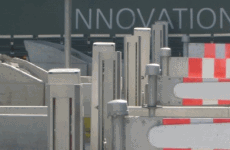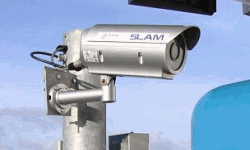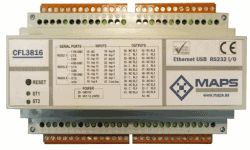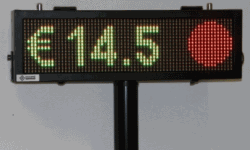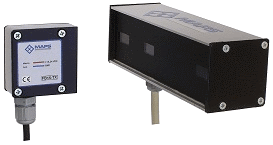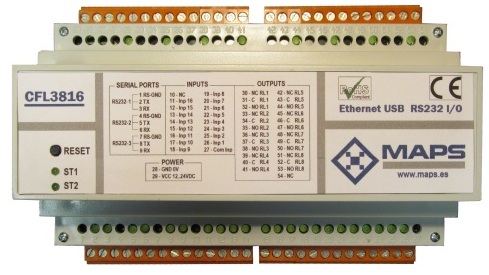|
OPTICAL BARRIER
MAPS CFxx
|
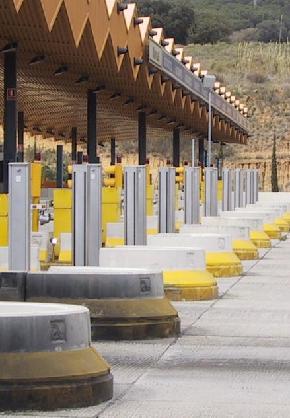
|
Optical barriers for vehicle detection and classification in tolls(MAPS CFxx)

They are exclusively developped for detecting vehicles taking into account the geometry and kinematics of these passing through the screen. Designed for outdoor operation, support direct sunlight, direct rain, dirt, degraded mode support system des / activating sensors affected by external agents (small animals, dirt, etc).
Main Functions:
- Vehicle Detection.
- Vehicle Classification.
- Separation between vehicles.
- Height over the first axle.
- Tow Presence.
- Axle Counting (double beam model).
- Vehicle crossing direction (double beam model).
Description of Optical Barriers MAPS CFxx
- Vehicle Detection.
- Vehicle Classification.
- Separation between vehicles.
- Height over the first axle.
- Tow Presence.
- Axle Counting (double beam model).
- Vehicle crossing direction (double beam model).

Detection and / or classification of vehicles in tolls is characterized by an extremely harsh environment. This variability has been fully addressed in the design and manufacture of the CFxx photoelectric curtains which have continuous improvements for more than 10 years. This environment, under which barriers work properly, could be summarized as follows:
- Environmental conditions: direct sunlight, hard shadows, rain .
- Dirt environment: tree leaves, paper or packs moved by the wind, flying animals or crawlers, etc .
- Variability of objects detected: motorcycles, cars, trucks, with all the variability at low, either fixed or hanging objects, etc.
The current configuration of the optical barriers is the result of years of development, conducting countless tests with real traffic and the experience of thousands of devices running on motorway tolls from various countries.
The cornerstones on which rests the great success of this product by our customers are:
- Their high reliability on the procided information (errors of 1 / 10,000 in vehicle detection [reliability = 99.99%]).
- High Performance independent of the speed of passing vehicles.
- It provides a large number of useful functions for traffic management.
| CFxx Technical Specifications | CF04P  |
CF24P  |
CF220M   |
CF220   |
CF300  |
| Beam Structure | Single Beam | Dual Beam | |||
| Vehicle Presence | Yes | ||||
| Vehicle Separation | Yes | ||||
| Height Detection | No | Yes | Yes | ||
| Hold Presence with Trailer | Yes | ||||
| Trailer Detection | No | Yes | |||
| Opertaing Height for Detection | 1,5m | 1,5m | 3,0m | ||
| Classification | No | Yes | |||
| Axles counter | No | Yes | |||
| Flow direction detecting | No | Yes | |||
| Reversible flow | Yes | ||||
| Speed range | [0..100] Km/h | ||||
| Error rate Presence | 1 / 10000 | ||||
| Error Autodetection | Yes | ||||
| Degraded Operation | Yes | ||||
| Protection degree | IP65 | ||||
| Solar and rain Inmunity | Yes | ||||
| Distancia between columns | 2,6 to 6m | 2,8 to 5m | 2,5 to 6m | ||
| Max. Distance (optional) | 9m | 10m | 10m | ||
| Relay Outputs | 1 | 2 | 2 | 4 | |
| Communications | No | RS232C | RS232C | RS232C/RS422 | |
| Ethernet (TCP/IP) | No | Optional | |||
| State Leds | Yes | ||||
| Operating Temperature | -20ºC to 75ºC | ||||
| Weight | 42Kg(*) | 70Kg | 110Kg | ||
| Power | 24VDC, 12W | 24VDC, 15W | 220VAC, 20W | 220VAC, 25W | |
| RoHS Directive | Yes | ||||
| Remote Update | Optional | ||||
Vehicle Classification by Optical Barriers MAPS CFxx
| Clasification with Optical Barriers | H=150 | H=240 | H=300 | |
| Model | Description | 7+1 Classes | 10+1 Classes | 13+1 Classes |
 |
Motorbike | M | ||
 |
Car without trailer [H < 1,5m] | A | ||
 |
Car with trailer [H < 1,5m] | B | ||
 |
Car with more than 2 axles, without trailer [H < 1,5m] | C | ||
 |
Mini Van with 2 axles [1,5m < H < 2,3m] | D | ||
 |
Van with 2 axles [2,3m < H < 3m] | D | G | G |
 |
Truck or Coach with 2 axles [H > 3m] | J | ||

 |
Mini Van with 3 axles [1,5m < H < 2,3m] | E | ||
 |
Van with 3 axles [2,3m < H < 3m] | E | H | H |
 |
Truck or Coach with 3 axles [H > 3m] | K | ||
 |
Mini Van with more than 3 axles [1,5m < H < 2,3m] | F | ||
 |
Van with more than 3 axles [2,3m < H < 3m] | F | I | I |
 |
Truck or Coach with more than 3 axles [H > 3m] | L | ||
 |
Not Identified | X | X | X |
Vehicle classification table by number of axles and height with MAPS CFxx Optical barriers

| Main Function | H=150cm | H=300cm | Specifications |
| PRESENCE (IP65) | CF24P | The CF24P optical barrier provides following functions:
|
|
| PRESENCE (IP65) | CF04P |
The CF04P optical barrier provides following functions:
|
|
PRESENCE & MOVING DIRECTION (IP65) |
CF220 | CF300 | Manufactured with a totally waterproof hardware, has a dual beam of infrared light. It is designed using a modular structure that allows heights up to 300cm.
The optical barrier provides following main functions:
|
PRESENCE & MOVING DIRECTION (IP65) |
CF220M | Equipment evolved from CF220, with more compact electronic hardware and with the same resolution.
Manufactured with totally watertight hardware, it has a dual beam of infrared light. It is powered at 24VCC and has 2 relays or 4 open collector outputs, providing similar functions to the CF220. |
|
PRESENCE & MOVING DIRECTION (IP55) |
CF200 | Manufactured with appropriate hardware to work under the toughest environmental conditions, both temperature and humidity. Provided with double shell closet and dehumidifier. Functional characteristics are identical to those of the CF150 device. | |
PRESENCE & MOVING DIRECTION (IP44) |
CF150 | [Discontinued equipment]
The CF150 optical barrier, with dual beam, provides following main functions:
|
| World Optical Barriers Installations | ||
|
Europe
Africa
Asia
|
America
|

|
| Accessories | |||
| Function | Model | Specifications | |
ADAPTER MODULE for HEIGHT Photocell CF-220 Optical Barrier |
FTCH | Adapter Module for Height photocell for CF-220 Optical Barrier: The MAPS CF-220 optical barrier family has a module as an accessory to accommodate up to 4 photocells (M138x) able to detect high vehicles. The adapter module can accommodate the photocell at different heights allowing to detect vehicles up to 250cm height. | |
| PHOTOCELL (IP54) | M138x | Throughbeam Photocell: Photocell MAPS-138x consists of two modules, one transmitter and one receiver which operate using a modulated beam of infrared light pulse, it works from 1m to 15m, in any ambient lighting, even sunlight, without any previous setting. | |
| PHOTOCELL FOR MOVING DIRECTION (IP54) | FTC2R | Double Throughbeam photocell: Photocell MAPS FTC2R has two infrared beams to detect objects and direction of movement. High speed (Tr = 8ms). Consists of an infrared transmitter module and a receiver. The receiver module incorporates a microprocessor to discriminate the direction of the object when it crosses the IR beam. | |
Hub / Converter RS232C / Ethernet Digital I/O / Ethernet |
CFL3816 | Ethernet / USB Controller: MAPS CFL3816 ethernet controller allows to control and monitorize field electronic equipment remotely via Ethernet or USB. Remote devices can be connected to the hub CFL3816 throught Digital I/O or its RS232Cx3 serial channels. Thus field devices, regardless of their interface, can be controlled or monitorized remotely from the office or from other computers / smartphones that have Ethernet / USB communication facilities. | |



